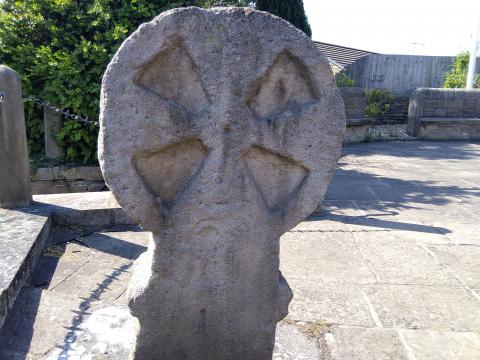Foulridge Cross

I recently walked to Foulridge, near Colne. By the ubiquitous village war memorial is the upper section of an old cross, placed in the ground. This has been dated to the twelfth century by Professor Richard Bailey in his Corpus of Anglo-Saxon Stone Sculpture, though such judgements are difficult to confirm with much degree of accuracy. Many places have their crosses’ stumps, such as Colne, with the upper parts vandalised or destroyed by idol-weary puritans. Quite how Foulridge’s top half survived but lower shaft did not, I cannot tell.
The item itself would have been a ‘preaching cross’. Before the network of parish churches were built, stone crosses were erected by which sermons would be preached. I cannot vouch for the truth and quality of the sermons this stone first heard: by the 1100s, the ‘Church’ was well and truly apostate, the Roman papacy that controlled it, a sewage-filled gutter. Still, the Lord has always reserved for Himself a people throughout every age and time, so the gospel of grace may well have sounded forth in the shadow of the Foulridge cross.
Meeting in comfortable buildings is not every Christian’s experience of worship. Many puritans were forced to meet in woods and glens, Covenanters on heath and moor. Today, believers abroad gather in secret for fear of persecuting authorities:
being destitute, afflicted, tormented- of whom the world was not worthy. They wandered in deserts and mountains, in dens and caves of the earth Heb 11:37-38
Wherever we meet, roofed or exposed, may we ever have the cross of Christ before us, our sermons composed in its shadow, its towering heights dwarfing the very preachers who proclaim its saving work.
But we preach Christ crucified 1 Cor. 1:23

Interestingly, the cross has upon it carved a pair of shears, just visible in the top picture. All manner of explanation and tales have been supplied to account for this, including one that the local tailor refused Cromwell’s order to make Roundhead uniforms. For such refusal, he was shot and buried by the cross. I would assert that had the Blessed Oliver come that way -for which there is no evidence at all- the cross would have been blasted to smithereens, never mind re-carved.
- Log in to post comments


 Sunday Worship 10.45am & 6.00pm
Sunday Worship 10.45am & 6.00pm